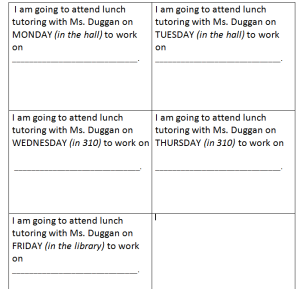Developing Systems to Encourage Reflection, Growth, and Mastery
by
Michaela Duggan
In her recent post, Bridget Adam talked about a tracking system she was implementing. In science we use a similar tracking system that has become integral to the instruction and culture of my class. The idea for having students track their mastery throughout a unit came from Anna Billa Rhea, the Tennessee Charter Association Teacher of The Year in 2012. The tracking system provides a concrete plan for all students to take their learning into their own hands and provides our class as a whole a common language with which to discuss progress. The tracking system I use today has gone through several iterations to reach its current format and usage; I’m sure moving forward the system will continue to evolve as I work to improve the efficiency and accuracy.
Small Changes, Big Differences
When I initially implemented the tracking system, students recorded their mastery on various assignments in the “Attempt” boxes and if they hit our class goal of 85% mastery, they put a star in the “Mastered!” box. Implementing this tracker improved students’ understanding of what they did and did not master; however, it did not provide an opportunity for students to improve their understanding of topics they had not yet mastered.
The “Action Steps” component of the tracker, added in the 2nd iteration, created a built in structure for continuous improvement. I started using exit tickets as a check for understanding. I grade these after school and pass them back during the Do Now the following day. Immediately following the Do Now, students take out the unit tracker pictured above and fill in the mastery percentage for the exit ticket. If students earned 85% or higher on the exit ticket, they draw a star in the “Mastered?” box. If students earned less than an 85% they choose one of the Action Steps listed at the bottom and write the number in the “Action Step” box. Action Step 1 is to correct the assessment. Students simply correct their exit ticket in a different color and resubmit it as evidence. Action Step 2 is Brain Builders (see below on Brain Builders). Action Step 3 is to attend lunch or tutoring (after school). In the version above there is an Action Step 4 of “Other,” but I no longer include Other as an option mainly because, students were not using it in an effective manner.
The evolution of my mastery trackers are shown below:
There are two differences in the third tracker above (which I am currently using) and the one that preceded it. First, the ‘Mastered Box’ is now the last column. This simple formatting shift helps emphasize the idea that mastery is the end goal and everything else is a step along the way to reach that goal. The second change is the example of a corrected assessment at the bottom. The intention behind students correcting their assessment is to identify their mistakes and correct them to improve understanding. In using the action step system this year, I noticed that students were quick to correct their assessments and complete the action step by comparing answers with their neighbor and filling in the correct response. Occasionally, these conversations included the rationale behind the correct answer but there was no check to ensure students truly understood the concept. Therefore in this unit, for a student’s corrections to count as their action step, the corrections should look like the example.
Brain Builders
 Brain Builders are also adapted from Mrs. Billa Rhea and are practice problems on the specified topic. These have also evolved over time. The set-up has remained the same—there is a hanging folder for each unit, with manila folders for each topic inside the hanging folder. In each manila folder there are extra practice papers. As you can see, it’s a little love worn 🙂
Brain Builders are also adapted from Mrs. Billa Rhea and are practice problems on the specified topic. These have also evolved over time. The set-up has remained the same—there is a hanging folder for each unit, with manila folders for each topic inside the hanging folder. In each manila folder there are extra practice papers. As you can see, it’s a little love worn 🙂
The original Brain Builders were simply additional questions about a particular topic. Students would complete the questions and submit their work as evidence of working towards mastery. A flaw to this system, however, lay in the possibility of students not knowing the material well enough to practice and improve their mastery. Therefore, this year I have revised the Brain Builders to include a review section at the top. In theory students have all the information they need to complete the practice on the paper itself. The image below shows the original and revised Brain Builder for food webs.
Tutoring
The tutoring action step has had fewer shifts over time. When  students come for tutoring, we start by looking at their tracker and identifying our area of focus. During these review sessions I often will use the Brain Builders as the practice which saves me from creating extra materials. The one adjustment I have made to the tutoring action step this year is the addition of a “pass.” The passes are shown below:
students come for tutoring, we start by looking at their tracker and identifying our area of focus. During these review sessions I often will use the Brain Builders as the practice which saves me from creating extra materials. The one adjustment I have made to the tutoring action step this year is the addition of a “pass.” The passes are shown below:
The pass has multiple benefits: 1) it lets my colleagues know the student has permission to see me during lunch 2) it lets the student know where I will be during lunch and 3) it requires the student to self identify what it is he or she needs help with prior to attending the lunch session.
Physical Environment
Inspired by the book, Switch by Heath and Heath, in which they site the physical environment of a situation as an obstacle for change, I decided to improve the environment by moving the location of materials in my classroom . In thinking about how to improve the action step system, I realized I needed to improve the environment. Originally, the Brain Builders crate was located in the back corner of my room near students’ cubbies and project work spaces—not a place students went on a daily basis in science class. For the last two units, I moved the Brain Builders crate to the table right next to the door. All students now walk by the crate—and therefore have a readily available opportunity to take practice they need. The new passes for lunch tutoring are also hung right above the crate in its new location.
Feedback: Balancing Accountability and Accuracy
Just because the “Action Steps” are readily available does not mean all students complete them independently. The largest struggle I have in using the action step system is balancing accountability with accuracy. Through the evolution of this system I have used multiple accountability structures. First, I simply had students show me on their fingers which action step they chose. This allowed me to make sure everyone knew what they were supposed to do for that topic and to check that students were following directions. The issue with this however was I was not able to tell when students actually completed the action step or if they were doing it at all.
Second, I tried giving each student a post-it and had them write their name and either “mastered” or the number of their action step and then stick it to the wall. I had two sections on the wall “Got It” where students who mastered the topic placed their post its and “Working On It” where students who still needed to complete action steps placed their post-it. Once a student completed the action step, he or she would move their post-it from the “Working On It” section to the “Got It” section. This would allow me to see who had not yet completed an action step and who I needed to follow up with. The problem with this system was we were adding roughly 100 post-its to the wall each day. As you can imagine, my classroom resembled trees loosing their leaves in the fall with all the post-its falling to the floor.
Third, I tried improving the “Got It” and “Working On It” structure using magnets. Each student had four different color magnets with his or her name on it. Each topic was assigned a color and students moved their magnets to the selected spot for the topic—either “Got It” or “Correct Assessment,” “Brain Builder” or “Lunch Tutoring” under “Working on It.”
The magnet system was definitely a source of excitement at first—students loved having their name on the wall and enjoyed the physical act of moving the magnet over. However, the magnet system became too time-consuming. Realizing this, I have not used the magnets for the last 3 units and I am looking forward to the hours I will not have to spend creating the magnets at the beginning of each year.
Now, to hold students accountable, I use a printed copy of the concepts to be mastered and a highlighter and track their progress myself. If a student has less than an 85% I highlight the box yellow. When the action step is completed, I cross out the box. If at the end of a unit, students have not complete the action steps independently, they are assigned to afterschool homework support where I give them a packet of Brain Builders for each topic they have yet to master and work with them to complete it. I frame it to students as “If you don’t choose to do something on your own, I will choose for you (which will all know is less fun).” After one unit, students realized it was better to complete action steps independently and immediately after an exit ticket rather than ending up with a packet at the end of the unit.
Restructuring Class for Growth
The Action Step system transformed my class. Growth and improvement became the basis of all conversation and put responsibility for taking action into students’ hands. We used the same routine every day and the expectation for success was clear. Each Friday, students complete a weekly reflection of their progress so far and a quick inventory of what they still need to do.
I started the action step system as part of my goal to help students become self-sufficient learners and develop a growth mindset. This system gives students the power to change their grade and take ownership of their learning. The first component of the tracker I highlight for students is the fact that there are 3 “Attempt” boxes—I do not expect them to mastery everything the first time. What I expect from them is to continue taking action until they have mastered the topic. Low mastery on an exit ticket does not mean a failing grade—it just means the topic wasn’t mastered yet.
Over the past 3 years of using the system it has evolved and I’m sure will continue to evolve as I work to balance holding students accountable with managing the volume of work that gets turned in through the action steps and checking for accuracy.



Pingback: Developing Systems to Encourage Reflection, Gro...·
Pingback: Developing Systems to Encourage Reflection, Gro...·
Pingback: Interdisciplinary Assessment: Combining Literacy, Science, and Mathematics | Transitioning to the Common Core·